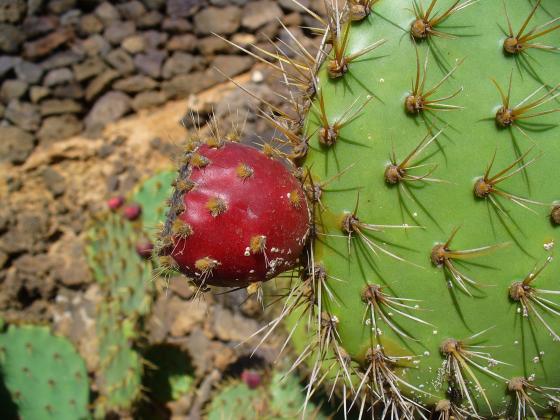Prickly pear cactus - Texas State Plant can purify drinking water
Backyard Horticulture
Opuntia spp., the several species of prickly pear cactus, are native to the Americas. They are stem succulents growing to 11 feet but may be prostrate. Erect, they’re about 3½ feet. The flat green pads, nopales, are branches, evergreen stem segments 8 to10 inches long and 5 to 7 inches wide. Some types are spineless, but most have needle-like spines, modified leaves. Glochids are hairlike spines or short prickles, usually barbed that can stick in flesh. They grow from areoles, raised bumps. Flowers, 2 to 3 inches, can be yellow, red or purple. Fruit, called pears or tunas, are 4 to 5 inches, deep red, juicy and sweet with many hard seeds. In addition to pollinators and seeds, the plant is propagated by piec-
Prickly pear cactus flowers are yellow, red , or purple. A dye is made from them.
es of the pad that break off. Opuntia spp. often forms clumps, colonies. They can interfere with the plans of landowners particularly those with livestock that may be injured from ingesting the spines.
Native American and Mexican cuisine use nopales as a vegetable and fruit. It is a natural thickener. It is cooked, pickled, dried, juiced, used to make jelly, candy, alcohol, etc. Fruit and flowers contain betalains, chemicals used as natural food coloring. No matter how the plant is eaten, the spines and glochids must first be removed to avoid serious mouth and intestinal problems.
Medicinally the plant is a traditional remedy of the native peoples of the Americas for burns, chronic diseases, particularly diabetes, obesity, cardiovascular diseases and cancer.
Opuntia spp. is in the Food and Drug Administration Poisonous Plant Database at fda.gov.
Opuntia spp. mucilage has been used to purify drinking water. There are interesting online videos. The plant is boiled, impurities settle to the bottom and the water on top is good to drink. The plant is being studied as a way to clean waterways. Below are some titles from the National Institutes of Health, ncbi.nlm.nih.gov.
• “Application of Opuntia ficus-indica in bioremediation of wastewaters. A critical review.”
• “Removing heavy metals in water: the interaction of cactus mucilage and arsenate (As (V)).”
• “Toward understanding the efficacy and mechanism of Opuntia spp. as a natural coagulant for potential application in water treatment.”
The mucilage is added to improve house paint. The plant is a source of fish hooks, needles, fiber, baskets, paper, candles, soap, etc. Cochineal, scale insects, live on Opuntia spp. pads and are grown as a source of the natural red-purple dye carmine. Carmine was valuable to Europeans who had never seen such a brilliant red. From the 16th to 19th centuries it was Mexico’s second-most valued export after silver.
In May 1995 the Texas Legislature adopted the prickly pear cactus, Opuntia spp., as the Texas State Plant. They said, “Rugged, versatile and beautiful, the prickly pear cactus has made numerous contributions to the landscape, cuisine, and character of the Lone Star State, and its unusual status as both a vegetable and a fruit make it singularly qualified to represent the indomitable and unique Texas spirit as an official state symbol.”
Opuntia fruit, tunas, is deep red, juicy and sweet used to make jelly, candy, etc.

